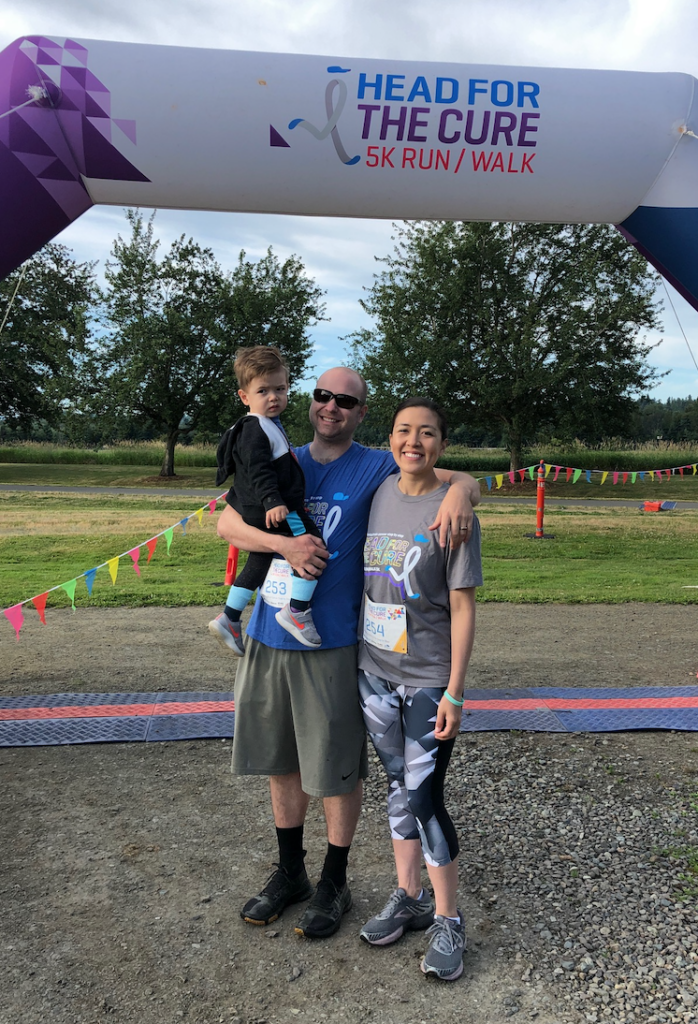April 28, 2020
My Treatment Journey Over the Past 21 Years.

Written by Head for the Cure Ambassador and Survivor Nicolle Mattingly
As I walk through my treatment journey with you, I would like to point out a couple of key points.
- This is my treatment journey, not a treatment plan. A plan insinuates that the steps were outlined ahead of time, with a clear path, and as you will read, that has not been the case; and
- I could not have made it to this point in my treatment journey without a team- my medical team and support network. I have a primary neurooncologist who manages my care and advises me every step of the way. I trust her and her team – their knowledge and expertise. I also seek opinions from another medical center and the National Cancer Institute.
Six surgeries, three types of radiation to my head, and BRAF inhibitor medication have all been part of my treatment journey over the past 21 years.
I had my first treatment in 1999, when I was 9 years old. I had a gross total resection (craniectomy #1) of an ependymoma followed up by 6 weeks of radiation.
I have always been told and understood that if it is possible, surgical resection is the preferred first treatment option. And it sure would be nice if that was always enough to keep the cancer from coming back. But, there is a good chance that even if you are able to undergo surgery, additional treatment post-surgery will be the recommended route, even if you had a “total resection” (depending on the type of tumor/cancer that you have).
Fast forward to 2014, I had another gross total resection (craniectomy #2), this time of an anaplastic pleomorphic xanthoastrocytoma (APXA) in my cerebellum. That time I did not have any post-surgical treatment, and had a rather uncomplicated recovery from surgery (in the hospital for 4 days, back to my normal activity level within a month).
Then in early 2016, the APXA came back, in the same location. I had another gross total resection (craniectomy #3) and this time, my surgeon referred me to a neurooncologist and a radiation oncologist. They both recommended that I undergo proton therapy radiation.
Now, because an APXA is a rare tumor type, and proton therapy radiation is also fairly new and not available everywhere in the country, there is no wealth of research with a recommended treatment plan for an APXA and most certainly not much to be found on treatment of an APXA with proton therapy. Therefore, I listened intently to everything my radiation oncologist told me regarding the benefits and possible side effects of proton therapy and did my own research to be as educated as possible and decided to go ahead with proton therapy. I was extremely fortunate that I lived within an hour of a proton therapy center, and side effects did not hit me too hard, so I was able to stay working during time.

Over the next two years, I got married and had a baby and was able to focus all of my energy on those exciting events as the brain cancer stayed at bay.
Soon after though, in 2018, and again in 2019, I had craniotomies #4 and #5 to remove recurrent tumor. It was in 2019, that my treatment started to incorporate an oral medication that inhibits a mutated gene that my tumor happens to have. Interestingly enough, it is a medication that was originally created for skin cancer, and has only recently been tried (and successful) in treating certain brain cancers that have that same genetic mutation. After trying different variations of the medication and dosages, my medical team and I decided to pause the medication as it did not seem to be necessary at that point and I was having pretty severe side effects.
Then, earlier this year, the APXA appeared to have spread to my spine and within my brain. I had a spinal surgery (laminectomy and surgery #6) to remove the new APXA tumor and a few weeks after surgery, I had a third type of radiation – Gamma Knife (stereotactic radiosurgery). In my experience, this is the treatment that had the biggest effect on me. I think a large part of that is I underestimated it. One day of treatment versus six weeks. You are admitted to the hospital, but go home that same day. I was caught off guard by the headaches that lasted for a week afterwards and the inflammation of my face from the localized anesthetic. Almost two months out, I am still recovering somewhat as I still have sore marks on my forehead where a metal frame was screwed into my skull to keep me absolutely still during the treatment.
Finally, now I am back on the oral medication (the BRAF – genetic mutation) inhibitors. The side effects I am experiencing now are minimal. I have become close friends with another brain tumor patient who is taking the same medication, so I can talk with her about her experiences. I have also found an online support group of brain cancer patients who are taking this medication, which helps me navigate coping with side effects (like the extreme sensitivity to sunlight that comes with these medications).

One time, when I was considering an oral medication treatment for my recurring brain tumors, my husband put it in these terms: the medicine was like a tiny army of microscopic warriors taking out the enemy whenever and wherever it showed up in my spinal fluid; and while I am not a proponent of violence, I am a proponent of kicking cancer in the rear in any way possible.
While these are my experiences with each treatment I have undergone, I have learned that responses to and experiences with treatments vary widely. If you are anything like me, that is frustrating. When I am confronted with a new treatment option, I want to know exactly what to expect, but that is not what we get. Instead, we trust our medical team, the experiences of others before us, and our own informed selves to decide what each of our treatment journeys will look like.